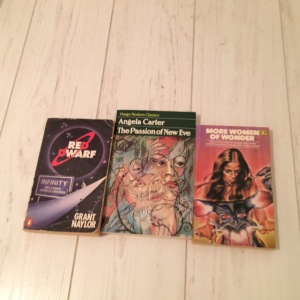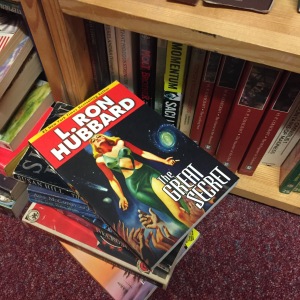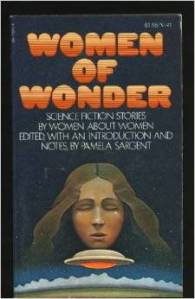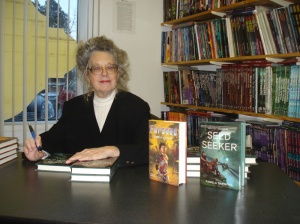As you may recall my recent reading rut was well and truly smashed by the science-fiction short story collection Women of Wonder. I have been seduced again by the short story, not feeling quite up to a return to novels. I spotted this collection of stories, Dangerous Women Part 1, in Eason’s Portlaoise and I knew had to have it. Thanks to a sneaky Dad, who always sees what I am scoping out at then grabs it and runs away to pay, I now have a book which promises to deliver lots of kick-ass, dangerous women.

In the introduction Gardner Dozois tackled the issue of how dangerous women inhabit space in genre fiction. There is no doubt in the real world, we all agree that women can be dangerous. Dozois gets a nod of approval from me as he uses the example of Amazons and Scythian tribes to demonstrate this, badass nomad warrior women who fought and died as warriors. Honourable women soldiers, pilots, and samurai all get a mention, as do terrifying highway-women, dastardly pirates and rare, but real, serial killers. These real-world examples of dangerous women do not often make in into the genre literature; too often women as cast as the docile daughter, love interest or victim or the main character. They are used to push other stories along rather than seizing the plot and taking it for themselves. But Dozois doesn’t end on that frustrating note and like Pamela Sargent’s introduction he gives us excellent examples of deadly and complex women characters to add to our ever expanding reading lists. This doesn’t always mean that women are always the heroes, they also make great villains which explore a wide range of emotions and the grey areas of morality. This short story collection, Dozois promises, will provide the latter. So how did the stories pan out?

Gardner Dozois
The first story was by a writer who really needs no introduction at this point, George R.R. Martin. I did learn something new from his author bio, George, it turns out, is quite the genre hopper. He began writing science fiction, then he moved onto horror before starting a series called A Song of Ice and Fire, I’m guessing you have heard of. If you are a fan of that world this collection is worth buying just for his story. His novella, The Princess and The Queen, or, The Blacks and The Greens, spans 81 pages and it gives readers who have been patiently waiting for The Winds of Winter something to tide them over. The story is packed full of dragons, alliances, betrayals and squabbling Targaryen royalty. It adds greatly to the canon of Westeros, bringing to life a story set before all the current shenanigans. So if you have quit the TV show, as so many people have these days, read this instead. 35,000 words of pure R.R.
The rest of the stories in the collection are a lot shorter than R.R. Martin’s, perfect for bedtime or bus reading. Raisa Stepanova, the next story to be included, is by Carrie Vaughn. I haven’t read anything by her before now as most of her work is in the supernatural genre. Werewolves, ghosts and ghouls are absent from this collection’s story as Vaughn focuses on a young, vibrant, talented Russian fighter pilot in World War II. I did not know that Russia had women working as pilots during this war; in fact one unit of women flew 30,000 missions, dropping 23,000 tonnes of bombs on invading German armies. Vaughn’s story was great and was definitely dangerous woman territory. There was plenty of ambition and rivalry among the women in the story but there was also friendship and camaraderie, something which can often be left out of stories involving more than one woman. Vaughn also explored the loneliness and anxiety of war from being away from loved ones. It was hard work being a badass, dangerous pilot.
Second Arabesque, Very Slowly by Nancy Kress brought me back to a familiar area of literature, post-apocalyptia. Kress, a Hugo and Nebula winner, shows us that even in the wake of a devastated world which has been torn-apart, beauty and softness can survive. The readers follow how the young people in this story work through the horrors of their existence to connect with ballet. The story is well written and I connected with the main character Nurse, with her all her hopefulness and helplessness.
I Know How to Pick ‘Em was the contribution from the New York Times bestseller Lawrence Block. Block is described as a mystery and crime genre writer and this story is crime 101. There is a dangerous woman in this story, I think Block was aiming for two but it didn’t really work for me. Ultimately I felt this story was a bit odd and it fell into too many noir-esque crime tropes which made it predictable. This one wasn’t for me.
Crime follows on from crime and Megan Abbott was next with her story My Heart is Either Broken. It had a strong Gone Girl feeling to it; a missing person, a suspect who looks as guilty as sin and an unsympathetic public and media. Abbot twists things by framing the story around a missing child and a mother and wife who is the assumed killer. We watch through the eyes of a loving husband as he tries to balance his feelings and what he experiences with what everyone else is telling him. Scary and tense, this story holds the readers attention and keeps them guessing until the end.
Joe R. Landsdale is another genre hopping author and his story, Wrestling Jesus, is featured next. It is not, as the title may imply, a tale about fighting off the patriarchal binds of Christianity. Rather it is about a man wrestling another man, who happens to be called Jesus. It is an entertaining story about a kid who is bullied and is then taken under the wing of a kindly, but gruff, old man who happens to be a badass in the ring. Standard Karate Kid territory. The relationship between Marvin and the old man is a sweet one, and I enjoyed watching how it grew and developed. As for dangerous women I get the sense that Landsdale’s inclusion of a seductress was the women to satisfy the brief. I would disagree however and I see Marvin’s neglectful mother, his only parent present in his life, as the dangerous woman. The story does struggle a little bit in my opinion to meet the brief, even the Mum stretches things a bit, but it was a fun read nonetheless.
Rounding out the collection is fantasy writer Brandon Sanderson’s Shadows of Silence in the Forests of Hell. With such a dramatic title one can be sure that we are strictly in the fantasy genre here. This story was, sorry George, my favourite one in the collection. Set in a creepy forest full of deadly, mindless ghost-like shades, we follow the fortunes of Silence, an inn-keeper and bounty-hunter who works hard to keep her family safe. I could easily have read an entire novel of about the adventures of Silence. I really liked her character and the world Sanderson built for her to live in. She is tough, resilient, smart and dangerous, as you would need to be to survive the monsters, and the people, in her forest home. Excellent story with the right amount of gruff to keep me happy.
I think the best things about short collections like this one are that you are exposed to new writers who otherwise you would not have encountered. There is also a Part 2 and Part 3 so we won’t be running out of dangerous women characters any time soon
Have you read Dangerous Women Part 1 or anything else by these authors? Or are you planning to? Leave your comments below!
Dangerous Women Part 1 is available in paperback and kindle formats.
Please note that some links in this post are Amazon Affiliate links. When you buy something through these links, I receive a commission that helps support this site. Thank you!






